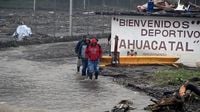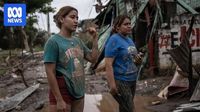Severe flooding and landslides triggered by days of relentless rainfall have devastated central and southeastern Mexico, leaving at least 42 people dead and dozens missing as of October 12, 2025. The disaster, described by authorities as one of the country’s worst flooding events in recent years, has struck with particular ferocity in the states of Veracruz, Puebla, Hidalgo, Querétaro, and San Luis Potosí. With search and rescue operations still underway, officials warn that the full extent of the tragedy may not yet be known.
According to the Mexican Government and the National Civil Protection Coordination (CNPC), the crisis began earlier in the week when two tropical storms—Priscilla and Raymond—brought massive downpours to much of the country. In Veracruz alone, more than 21 inches (533.4 mm) of rain fell between October 6 and 9, causing local rivers to burst their banks and unleashing torrents of water into streets and homes. The National Meteorological Service (SMN) attributed the catastrophic rainfall to a stationary low-pressure system drawing moist air from the Gulf of Mexico, compounded by the effects of the tropical storms.
The numbers paint a grim picture. As reported by AP and Watchers News, at least 42 people have died, with 27 others still unaccounted for. In Hidalgo, 16 fatalities were confirmed after hillside collapses and flash floods destroyed homes, severed power lines, and isolated 150 communities. Puebla reported nine deaths and more than 16,000 homes damaged or destroyed. Veracruz, one of the hardest-hit states, recorded 15 deaths and 42 communities left isolated by landslides and overflowing streams. Querétaro suffered additional casualties, including the tragic death of a child caught in a landslide. San Luis Potosí also faced significant impacts, though details remain scarce as rescue teams struggle to reach remote areas.
The scale of destruction is staggering. Streets in cities like Poza Rica, Veracruz, were inundated by over four meters of water at dawn on October 10, according to Reuters. Residents described waking to the sound of cars crashing together as floodwaters surged through neighborhoods. "We thought he had gone, that he had evacuated with all of those who left," said Shadack Azuara, who discovered his uncle had drowned after failing to escape the rising water. The aftermath was a scene of chaos: cars hung in treetops, a dead horse was found wedged inside a pick-up truck, and homes were left coated in mud and debris.
Across the affected states, thousands of soldiers and emergency personnel from the Secretariat of National Defense (SEDENA), National Civil Protection System (SINAPROC), and federal teams have been deployed to support evacuations, reopen roads, and deliver relief supplies. According to Watchers News, rescue units have focused on clearing debris, restoring power, and providing aid to those cut off by floodwaters. In Veracruz, the army and navy worked to rescue residents from isolated communities, while heavy equipment rumbled through dark, muddy streets as night fell—often with little presence from the National Guard or army, leaving residents to begin cleaning out their homes and businesses on their own.
The disaster has left more than 320,000 people without electricity, with outages reported across the Gulf coast’s 55 municipalities. Hospitals, public infrastructure, and homes have suffered widespread damage. In many areas, highways, streets, and entire villages remain submerged. The SMN has warned that additional rainfall is likely through the weekend, maintaining a high risk of renewed flooding and landslides, particularly in already saturated regions. Civil protection authorities have urged residents to heed evacuation advisories and avoid crossing flooded roads or riverbanks.
Mexican President Claudia Sheinbaum convened a virtual meeting with the governors of the five worst-affected states to coordinate emergency response efforts. "None of the victims will be left without assistance. Teams and officials from the federal government have been deployed to reopen roads and deliver aid to the public," Sheinbaum stated, as reported by Mexican media. Despite these assurances, fears persist that the situation could deteriorate further, with ongoing heavy rainfall threatening more landslides on mountain slopes and additional river overflows.
The human toll extends beyond the official statistics. In Poza Rica, a low-lying oil town northeast of Mexico City, residents recounted the terror of the flood’s arrival. Some sensed danger hours before and managed to flee with a few belongings, but others were caught off guard. As reported by AP, neighbors gathered around damaged homes, sharing stories of loss and survival, while some looted supermarkets for basic supplies in the absence of electricity and official support. The psychological scars of the disaster are likely to linger long after the waters recede.
Nature’s fury was felt across an astonishingly broad swath of the country. According to Mexican civil defence authorities, intense rainfall was recorded in 31 of Mexico’s 32 states, causing rivers to overflow, flooding entire villages, triggering landslides, and collapsing infrastructure. Rescue teams have raced against time to reach cut-off towns and assist affected communities, but the sheer scale of the disaster has stretched resources thin.
As the days pass, the focus has shifted from immediate rescue to recovery and rebuilding. Thousands of people remain without homes, livelihoods, or basic necessities. The government has promised continued support, but for many, the road to normalcy will be long and arduous. The disaster has also reignited debates about Mexico’s preparedness for extreme weather events, the resilience of its infrastructure, and the need for better early warning systems—issues that are likely to remain in the public eye as the nation grapples with the aftermath.
For now, the people of Veracruz, Puebla, Hidalgo, Querétaro, San Luis Potosí, and beyond are left to pick up the pieces. The stories emerging from the flood zone are a testament to both the fragility and resilience of those affected. As rescue and recovery efforts continue, the hope is that the lessons learned from this tragedy will lead to stronger protections and a safer future for communities across Mexico.





